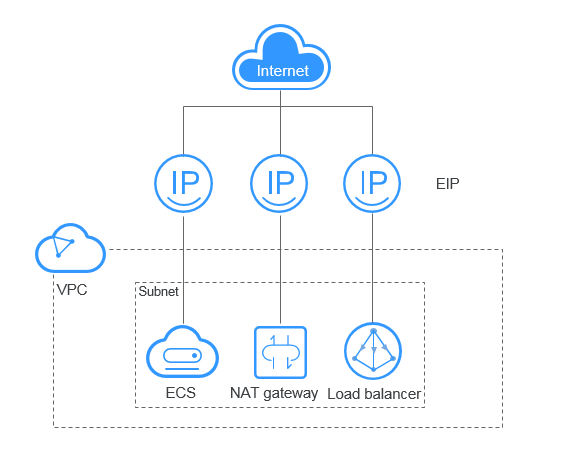EIP Overview
EIP
The Elastic IP (EIP) service enables you to use static public IP addresses and scalable bandwidths to connect your cloud resources to the Internet. EIPs can be bound to or unbound from ECSs, BMSs, virtual IP addresses, NAT gateways, or load balancers. Various billing modes are provided to meet diverse service requirements.
Each EIP can be bound to only one cloud resource and they must be in the same region.

EIP Quotas
If you want to know the number of EIPs that can be assigned in a region, see How Do I View My Quotas?
- Your request for a larger quota will only be approved if your account has valid orders and you are continuously using cloud resources. If you have released resources immediately after subscribing to them multiple times, your request for quota increase will be declined.
- If you have increased the EIP quota but you have not used the quota for a long time, Huawei Cloud will reduce the quota to the default value.
EIP Advantages
- Flexibility
An EIP can be flexibly associated with or disassociated from the ECS, BMS, NAT gateway, load balancer, or virtual IP address. The bandwidth can be adjusted according to service changes.
- Flexible billing
EIPs are available on a pay-per-use (bandwidth usage or amount of traffic is billed) basis. The yearly/monthly billing mode is more preferential.
- Shared bandwidth
- Immediate use
EIP binding, unbinding, and bandwidth adjustments take effect immediately.
Notes and Constraints
- An EIP and its bound cloud resource can use different billing modes.
For example, a yearly/monthly EIP can be bound to a pay-per-use ECS.
- If the used EIP bandwidth exceeds the purchased size or is attacked (usually by a DDoS attack), the EIP will be blocked but can still be bound or unbound.
- EIPs cannot be transferred across accounts. That is, an EIP of account A cannot be transferred to account B.
Feedback
Was this page helpful?
Provide feedbackThank you very much for your feedback. We will continue working to improve the documentation.See the reply and handling status in My Cloud VOC.
For any further questions, feel free to contact us through the chatbot.
Chatbot








